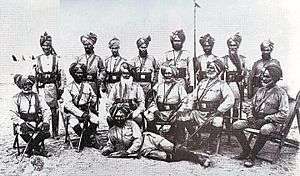4th Horse (Hodson's Horse)
| 4th Horse (Hodson's Horse) | |
|---|---|
 | |
| Active | 1857 – present |
| Country |
|
| Branch |
British Indian Army Indian Army |
| Type | Cavalry |
| Size | Regiment |
| Nickname(s) | The Flamingoes |
| Anniversaries | Cambrai Day Raising Day, 30 November 1857 |
| Battle honours |
Delhi Lucknow Suakin 1885 Chitral Punjab Frontier World War I France and Flanders 1914–18 Battle of Givenchy 1914 Battle of the Somme 1916 Battle of Bazentin Battle of Flers–Courcelette Battle of Cambrai 1917 Action of Khan Baghdadi Mesopotamia 1916–18 Battle of Megiddo (1918) Battle of Sharon Capture of Damascus Palestine 1918 |
| Commanders | |
| Notable commanders |
WSR Hodson Osmond Barnes Guy Beatty |
4th Horse (Hodson's Horse) is a cavalry regiment of the Indian Army which originated as part of the British Indian Army.
History
It was raised by Brevet Major William Stephen Raikes Hodson during the Indian Rebellion of 1857, and exists today as the 4th Horse Regiment in the Indian Army. The first risala or troop was raised by Risaldar-Major Man Singh.
The force was raised as an irregular cavalry regiment to assist with putting down the rebellion, and continued as part of the British Indian Army. The official designation has changed several times since the regiment's inception in 1857. In 1859, the regiment was split up into two regiments which survived broadly as the 9th Bengal Lancers and 10th Bengal Lancers. In 1878, the 10th Bengal Lancers came to be known as the "Duke of Cambridge's own." In 1921, the British decided to cut down on the number of cavalry regiments, and re-amalgamated the two as the 10th Duke of Cambridge's Own Lancers (Hodson's Horse).

The regiment fought at the Battle of the Somme and the Battle of Cambrai in the First World War. It still recalls the latter as the regiment's most splendid battle, and celebrates Cambrai Day every year.
The regiment is now an armoured regiment of the post-independence Indian Army.
Name changes
- 1857 Hodson’s Horse
- 1858 2nd Regiment of Hodson’s Horse
- 1861 10th Regiment of Bengal Cavalry
- 1864 10th Regiment of Bengal Cavalry (Lancers)
- 1874 10th Regiment of Bengal Lancers
- 1878 10th Bengal (Duke of Cambridge’s Own) Lancers
- 1901 10th (Duke of Cambridge’s Own) Bengal Lancers (Hodson’s Horse)
- 1903 10th Duke of Cambridge’s Own Lancers (Hodson’s Horse)
Notable officers
- Colonel George Lindsay Garstin, joined the 9th Bengal Cavalry on 3rd August 1877, and served in the Second Afghan War 1880 (Battle of Suakin) and led the regiment in the Chitral relief column. He possibly invented the wristwatch in the 1890s, getting a relative, Arthur Garstin (trading leather goods in Bloomsbury, London) to fashion him straps for his pocket watch. He commanded the Regiment 1894 - 1901.
- Major William Stephen Raikes Hodson, Commanding officer on formation.
- Colonel Osmond Barnes, commanded 10th Bengal (Duke of Cambridge’s Own) Lancers and was Chief Herald of India
- General Sir Henry Dermott Daly
- Risaldar-Major Man Singh, raised the first troop or risala
- Risaldar-Major Mir Dad Khan, Tarin/Tareen, father of Pakistani general and president Ayub Khan.
Photographic image, 1858

This is a photograph about whose subjects there is disagreement in reputable academic circles. (1) www.britishempire.co.uk states the Europeans to be: Lt. Clifford Henry Mecham (standing); Major Henry Dermot Daly (seated); The Sikh officer standing at the far left with long beard is given as Man Sing; the Sikh seated on floor as Jai Singh. (2) National Army Museum, London, names the European officers as: Lt. Clifford Henry Mecham (standing); Asst. Surgeon Thomas Anderson (seated). (3) The Bridgman Art Library gives the European officer seated as Major William Stephen Raikes Hodson; officer standing: Lt. McDowell and seated on the ground is Sikh officer Risalder major Man Singh. The attribution to Hodson is surely incorrect, unfortunately, as there is apparently otherwise only one extant image of this famous officer, the engraving printed as frontispiece to his biography "Rider on a Grey Horse", by B.J. Cork, 1958. There appears to be no disagreement as to the title of the photograph, or its year. Reputable officers : Major Bhupinder Singh, Mahavir Chakra, posthumous. 1965 Indo Pak war.
References
- Kempton, Chris. A Register of Titles of the Units of the H.E.I.C. & Indian Armies 1666–1947.
- Gaylor, John. Sons of John Company: The Indian and Pakistan Armies 1903–1991.